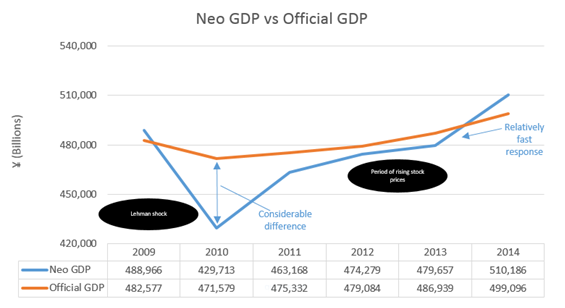Neo GDP
2016.10
Gross Domestic Product (GDP), is a widely used indicator for measuring the total value of goods and services produced by a country each year. At the heart of GDP statistics are input-output tables which set out the interdependencies in an economy. However, some of the key shortcomings of the traditional input-output tables include lack of timeliness, limited regional coverage and inability to delve down to individual data.
In collaboration with the Tokyo Institute of Technology, Teikoku Databank (TDB) has been undertaking a project on compiling new input-output tables that address much of the shortcomings of the traditional tables. The new input-output tables are compiled using inter-firm transactions data and permit the production of more timely and regional based GDP.
Neo-GDP vs Traditional GDP
Initial estimates of neo-GDP series compiled using new input-output tables together with the traditional GDP is shown in the diagram below. As can be seen, the neo-GDP series is more sensitive to economic trends than the tradition GDP series, offering a new perspective when looking at the real economy.

A better understanding of regional differences
Additional distinguishing feature the neo-GDP series include:
One of the key features of neo-GDP statistics is the ability to be disaggregated at the subnational level. Using the neo-GDP series, it was found that the growth rate in neo-GDP over the three year period 2011-2014 was 28% in Fukushima Prefecture, 11% in Miyagi Prefecture and 18% in Iwate prefecture. This compares with a 3% growth rate in Tokyo. The relatively high growth rates in the Tohoku region is attributed to the increased inflow of funds into the region for reconstruction efforts following the Great East Japan Earthquake of 2011. Growth disparities among neighboring prefectures also become apparent with subnational neo-GDP statistics. For example, it was observed that in the Shikoku region, Kagawa and Kochi Prefectures had achieved considerable economic growth, while Tokushima and Ehime Prefectures experienced significant negative growth over the same period, despite being in the same region.
A better understanding of the industries and companies driving the subnational neo-GDP
Gunma prefecture had one of the highest growth rates of 35% over the years 2011-2014. Drilling down to industry level statistics, it was found that `transportation machinery and equipment manufacturing’ industry which accounted for 35% of Gunma’s GDP was driving the Prefecture’s substantial growth. Furthermore, Ota City, which had a high level of activity in the ‘transportation machinery and equipment manufacturing’ industry, was identified as a key contributor to the Prefecture’s growth. Further analysis into ‘transportation machinery and equipment manufacturing’ companies in highlighted that Ota city was home to 39 manufacturers who were key suppliers to Fuji Heavy Industries. Of these 39 manufacturers, 30 had increased their output considerably over this period. It is understood the good performance of Fuji Heavy Industries' had increased demand for key inputs produced by local manufacturers and had contributed to Gunma Prefecture’s substantial growth.
Conclusion
Using neo-GDP data to analyze Gunma and Ota City’s economic growth showed that enterprises trading with large companies had contributed substantially to the regional growth. Therefore, neo-GDP statistics provide a micro perspective of the industries and companies that are influencing the local economy. This valuable micro perspective can in-turn be used to identify industries/companies that need to be targeted to achieve regional revitalization. Therefore, neo-GDP and new input-output tables are of considerable value for multifaceted decision making.
1 T, Ohsato., H, Deguchi. and K, Akagi. 2016. Input-Output Table constructed with private business establishment on company information data. Proceedings of the Japanese Society for Artificial Intelligence.
2 M.Takayasu, et al., In preparation
Tokyo Institute of Technology, School of Computing, Deguchi Laboratory
TDB Advanced Data Solutions Division, Takaya Osato